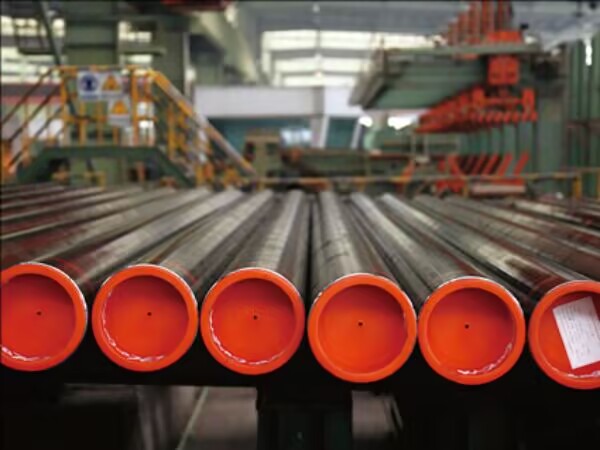Carbon steel pipes are steel pipes with carbon as the main alloy component, widely used in the transportation of industrial fluids, especially playing a dominant role in natural gas and oil pipeline systems.
In the oil and gas industry, carbon steel pipes have become the preferred material for long-distance pipelines and downhole casing due to their excellent strength, high pressure resistance and high temperature resistance, as well as their good cost-effectiveness.

Classification and Standards
API 5L series
Scope and level: The API 5L standard is for oil and gas pipeline transportation systems and is divided into PSL1 (Basic level) and PSL2 (Fine Level), covering two types of seamless pipes and welded pipes, with mechanical grades ranging from X42 to X70.
Other commonly used standards
ASTM A53/A106: ASTM A53 is applicable to black pipes, galvanized welded pipes and seamless pipes, and is mainly used for low-pressure transportation of water, gas and steam; ASTM A106 is for high-temperature service seamless tubes.
ASME B31.8: This code is applicable to the design and inspection of natural gas transmission and distribution systems and is one of the important standards for pressure pipelines.
Different types of seamless steel pipes used in the oil and gas industry
Carbon steel seamless pipe: Carbon steel pipes are widely used in the oil and gas industry due to their excellent strength and corrosion resistance. They are often used for transporting natural gas, oil and other hydrocarbon fluids. These pipes are manufactured using seamless processes, including heating solid billets and then piercing them to form hollow tubes.
Alloy steel seamless pipe: Alloy steel pipes are renowned for their high strength, corrosion resistance and high-temperature resistance. By adding other metal elements to steel, alloy steel pipes have excellent performance and are suitable for demanding applications.
Stainless steel seamless pipes: Stainless steel pipes have extremely strong corrosion resistance and are ideal choices for environments with high humidity or high chemical corrosion. They are usually used in offshore oil drilling platforms, ship applications and refineries. Stainless steel seamless pipes feature outstanding durability, reliability and low maintenance requirements, making them the preferred choice for critical applications.
Duplex and super duplex seamless pipes: Duplex steel and super duplex steel pipes are duplex stainless steels with excellent corrosion resistance and high strength. These pipes are particularly suitable for environments where there is a risk of chloride-induced stress corrosion cracking, such as offshore platforms and submarine pipelines. Duplex steel and super duplex seamless steel pipes have excellent resistance to pitting corrosion, crevice corrosion and erosion.
Nickel alloy seamless pipes: Some applications in the oil and gas industry require pipes to have excellent high-temperature resistance, corrosion resistance and the ability to withstand extreme pressure. Nickel alloy pipes can meet these requirements. Nickel alloys (such as Inconel and Monel) possess excellent heat resistance and corrosion resistance, making them highly suitable for use in chemical processing plants, seawater desalination facilities, and high-temperature environments.
Advantage
High strength and pressure resistance: The reasonable control of carbon content ensures that the pipe material not only has sufficient yield strength but also can withstand the high working pressure during pipeline transportation.
Excellent high-temperature resistance: Within the common temperature range for oil and gas extraction and transportation (-20 ℃ to +150℃), carbon steel pipes can maintain stable performance.
Economy: Compared with alloy steel or stainless steel, the material cost and processing cost of carbon steel pipes are both lower, and the production process is mature with a short delivery cycle.
Corrosion and Protection
Corrosion mechanism: Common CO₂ corrosion, hydrogen sulfide corrosion and stress corrosion cracks, etc., need to be evaluated in combination with the on-site medium composition.
Anti-corrosion measures: The outer wall is often coated with epoxy zinc-rich primer, three-layer polyethylene (3PE) or epoxy powder coating (FBE). At the same time, it should be combined with the cathodic protection system to extend the service life of the pipeline.
Quality control
Chemical and mechanical testing: During production, each batch of steel needs to undergo chemical composition analysis and mechanical property tests such as tensile strength and hardness, and an MTR or CMTR report should be issued to ensure traceability.
Non-destructive testing: Methods such as radiographic testing, ultrasonic testing, magnetic particle testing and penetrant testing are used to inspect internal defects in welds and base materials to ensure the integrity of the pipe.
Dimensional and appearance inspection: Strict inspection is carried out on the outer diameter, wall thickness, straightness and end face cutting quality. At the same time, the thickness and adhesion of the anti-corrosion coating are confirmed during acceptance.
